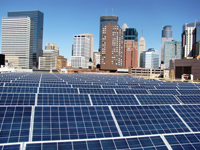
Big box stores and other large energy consumers are increasingly turning to solar power. Photo: minneapolismn.gov
Thanks to shareholder proposals filed by As You Sow, two of America’s largest utilities have agreed to report on their plans for a low-carbon future.
This spring, both Southern Company and FirstEnergy agreed to report on C02 reduction strategies. FirstEnergy pledged to examine various CO2 reduction strategies, review the age and lifespan of its existing fossil fleet, and research how increased standards of performance and environmental regulation will affect the company. Southern Company followed FirstEnergy’s lead by announcing it would publish a report on its renewable energy investments. The report details both current sources of renewable energy and projects expected to come online by 2015.
With new pollution rules from the EPA making it costly to open new coal plants, and with old plants being closed across the nation, utilities are recognizing coal as a financial risk. The consensus among industry analysts is that nearly half of U.S. coal-burning plants are over 40 years old and could be retired in the very near future.
Between extensive coal plant closures and the rapid adoption of solar, utilities are in a quandary. Utilities’ highest value customers, such as large box stores, are replacing utility services by installing their own solar panels to lock in long term fixed rates. This trend has caught Wall Street’s attention. Barclays recently downgraded the corporate debt for all U.S. utilities from “market weight” to “underweight”, stating that they believe that solar “…could reconfigure the organization and regulation of the electric power business over the coming decade.”
These negotiated withdrawals indicate that utilities are increasingly aware they need to change. Companies which aggressively adopt climate-friendly power are some of the most profitable and admired in the sector. It’s time for utilities to build a better business model.
Read more about our work with coal-burning utilities on our Coal page.











